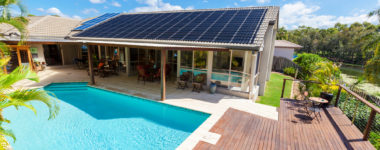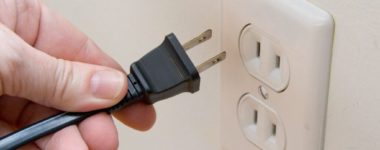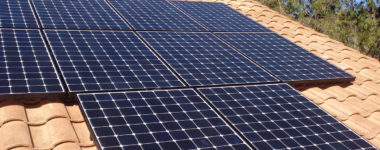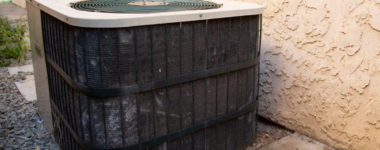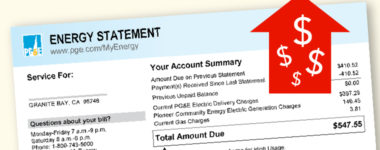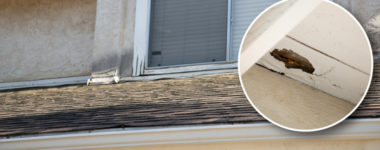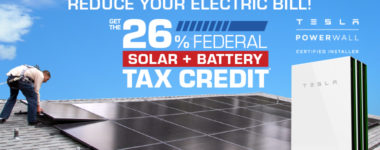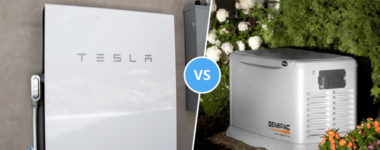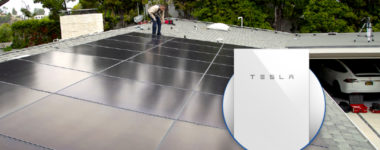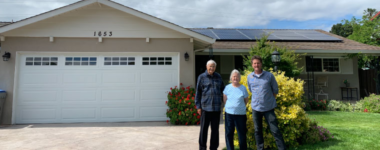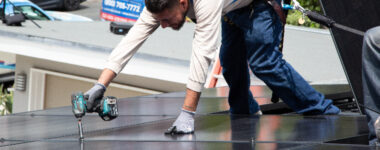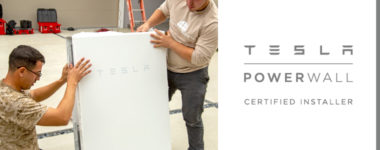Blog Post | Solar Panels, Battery Storage, Roofing, HVAC
Does Going Solar Make Sense In San Diego? The San Diego region is blessed with an abundance of sunlight, making it an ideal location for solar power. Solar panels installed in San Diego can generate enough electricity to power a home or business, and the region's climate means that panels will typically experience little wear and tear. Reasons To Go Solar San Diego If you're considering solar power for your home or business, San Diego is a great place to do it. Solar power is generated by converting sunlight into electricity. Solar panels are made up of many solar cells, and when sunlight hits these cells, it knocks electrons loose. These loose electrons flow through the material to create an electric current. This current can then be harnessed and used to power homes and businesses. Solar power is a renewable, clean, and efficient source of energy, making it a smart choice for San Diego residents. With an average of 260 sunny days per year, San Diego has the potential to generate a significant amount of solar power. Solar panels require little maintenance and have a long lifespan, making them a cost-effective investment. Making the switch to solar power can help reduce your carbon footprint and support the move towards a more sustainable future. Solar Panel Installations San Diego Overall, solar power is a great choice for San Diego residents. With plenty of sun and little wear and tear on the panels, solar power can save you money in the long run. Plus, it's good for the environment!
Does Going Solar Make Sense In Manteca? Solar power is one of the most efficient and cleanest sources of energy available today. There are many factors to consider when deciding if solar power is the right investment for your home. In Manteca, California, Going Solar often makes sense because of the high cost of traditional utility power, the abundance of sunlight, and state and federal incentives. Solar Panel Installation Companies Manteca California Solar power is one of the most popular forms of energy available today. Beginning with Solar panel installation is a great way to reduce your carbon footprint and save money on your energy bill. Solar power is also a renewable resource, meaning it can never be used up or depleted. Solar Panel Installation Process Manteca Residents Just remember, Solar panel installation is a simple process that can be completed in a few hours. First, the panels are mounted on the roof of your home. Next, the electrical wiring is connected to the Solar system. Last, the electrical wiring is connected to the main electrical grid. Solar power is then generated when the sun shines on the Solar panels. In conclusion, solar power can save you money in a few different ways. First, you will no longer have to pay for electricity from the utility company. It is also free once the initial investment has been made. Second, you may be eligible for state and federal incentives. These incentives can significantly reduce the cost of Solar panel installation. Solar Manteca California Solar power is a great investment for homeowners in Manteca, California. The high cost of traditional utility power, the abundance of sunlight, and state and federal incentives make Going Solar a smart financial decision. Semper Solaris can save you money on your electric bill, and may even make you eligible for rebates and tax credits. With Solar panel installation from the best Solar company Semper Solaris, you can start saving money and doing your part to protect the environment.
Best Solar Companies Campbell If 2.5 million American households have already gone solar, there's a good reason: it's a wise investment! Solar panel installations compensate for the power cost you might have endured for 25 years or more every month. Moreover, if you now spend $150 a month on power, you'll spend $65,000 on electricity in the next 25 years. By going solar, you may save a lot of money on power in the future. Solar financing allows households to pay for a solar system in periods, rather than all at once, utilizing methods like loans and leases. Solar Campbell Financing Options In You can purchase solar systems by cash, a solar loan, or leased/purchased with a solar power purchase agreement. PPAs and Solar Leases for all surrounding San Jose cities. Enjoy the Best Solar Panel Company Installation pricing in northern California. It's never too late to go Solar Almaden San Jose 95120. However, despite their drop in popularity over the last decade, power purchase agreements (PPAs) and solar leases were important for developing the solar sector. There are striking similarities between power purchase agreements (PPAs) and solar leases; that's why we call them "solar leases." Solar panels are installed on the land and then sold to you at a fixed rate by a former owner in both circumstances. There are minor differences between leasing and PPAs, but they are comparable enough to have been considered a unified unit. We server all of San Jose including Solar Panel Installations Sierra Azul Open Space Preserve 95120. Many leases and PPAs enable you to have you locked in electricity costs of 10 to 30 percent lower than you're now spending. Previously, the cost of leasing and PPAs rose annually. However, this is no longer applicable; instead, the price of leasing and PPAs remains stable every year, rising steadily. Furthermore, with a PPA/lease, a third company takes care of maintenance, so you know your solar panels are safe. You do not own solar panels when you use a lease or PPA. This indicates that the price of a solar-equipped house is 3-4 % higher than a comparable household without solar. Solar Loans Solar Panel Installation Companies San Jose 95050-56 There are two significant ways to acquire a solar panel system: solar loan and solar ownership. Solar loans are an excellent way to go solar and own your system without putting any money down. So, you can now pay for electricity at a lower cost. If you can pay your monthly electricity, you can afford to place solar panels on your roof via solar financing. Are you confused about the difference between a solar loan and a solar lease or PPA? Know that, unlike a solar lease or PPA, a solar loan allows you to retain ownership of your solar system. In other words, if you get a solar loan, you'll be able to reap the benefits of any government rebates and incentives. Still, you'll also be liable for any future upkeep on the solar panel system.
Eco-Friendly Home Improvements That Save You Money Purchasing a home is already a large investment, but to make the most of this asset, you’ll need to spend some time and money upgrading it. Doing so can increase the overall value of your property and help you save money on monthly expenses. However, not all home upgrades are created equal. You have to be deliberate in how you change your home to benefit, both financially and personally, from updating it. To that end, here are some of the best improvements you can make to your home: Install Solar Panels Consider getting solar panels for your home. Though you’ll have to spend some money to have them installed, you can look for solar incentives, tax credits, and rebates to reduce those upfront costs. It will likely take several years for your solar panels to pay for themselves, but in time, solar panels can help you save money on your monthly utility bills. Look into solar battery storage for additional savings. A battery allows you to store more of the sun’s energy for later use, even during a blackout or power outage. If it’s allowed in your area and you manage to generate enough power, you can even make money from your solar panels by selling your power back to your utility company. Additionally, solar panels will boost the value of your home. Like remodeling your kitchen or putting in a pool, solar panels are a home upgrade, and buyers will pay extra for it. One study discovered that buyers are willing to pay $15,000 more for a solar home. Keep in mind that the actual value of your home may differ greatly, depending on the local housing market and demand for solar in your area. Switch to Energy-Efficient Appliances The U.S. Energy Information Administration (EIA) reports that heating, cooling, lighting, and refrigeration account for the majority of annual household energy use. This means that your refrigerator, washer and dryer, dishwasher, and other appliances are likely the biggest users of gas and electricity in your home and the biggest charges on your utility bill. If you haven’t made the switch already, swap out your existing appliances for ones that use less energy. Simple upgrades, like changing out your incandescent light bulbs for LEDs, can make a surprisingly large difference for the environment and your wallet. However, if you’ve got the budget for more significant changes — like updating your HVAC system or getting a tankless water heater — they’re certainly worth making. You will have to spend some money to purchase and install your new appliances. But, because they use energy more efficiently, you won’t be paying as much for your power and gas bills each month. You can also use the ENERGY STAR Rebate Finder to look for discounts and special offers that reduce the upfront cost of upgrading your appliances. Use Low-Flow Fixtures Similarly, low-flow water fixtures benefit both your finances and the environment. Simply put, they help reduce your water usage, which, in turn, lowers your water bill. The U.S. Environmental Protection Agency (EPA) estimates that switching out a single bathroom faucet can decrease water flow by at least 30%. As a bonus, low-flow fixtures can also reduce energy costs. When less water runs through your faucet at a given time, your water heater uses less power to warm it up. To enjoy these benefits, all you have to do is purchase and install low-flow fixtures in your home. These fixtures are fairly inexpensive and usually simple to install on your own. Use the EPA’s WaterSense Product Search to find low-flow toilets, faucets, showerheads, and other fixtures. You can also shop for them at most hardware stores, but look for the EPA’s WaterSense label to ensure the fixture meets their efficiency standards. Update Your Roofing You should also consider updating the roof of your home. This is an inevitable expense for homeowners, as all roofs deteriorate over time, no matter what roofing materials were used in their construction. After all, they are designed to protect your home from the elements and keep you safe and comfortable when you’re inside. Further, leaving your roof in shambles can have costly consequences, such as leak damage or decreasing the overall value of your home. Not only does updating your roof help you avoid those expenses, but it can also help you save money. What’s more, depending on the work you do, this may also increase the overall value of your home, especially if you have plans to sell it soon. To keep things affordable, you may want to stick to patching holes, fixing loose shingles, or simple fixes. If you can, though, it may be worth doing a complete overhaul. There are also new roofing materials that make your home more energy-efficient and better protect it from the elements. By replacing your entire roof, you stand to get the most value out of your investment and reap the benefits of a new roof for years (if not decades) to come. Plant More Trees On top of boosting your curb appeal, planting trees on your property can have a dramatic impact on your energy usage. Researchers have discovered that planting shade trees can reduce the amount of energy buildings use for cooling and heating. In addition, the Partnership for Home Energy Efficiency reports that shade trees can lower the air temperature by three to six degrees, helping you save $100 to $250 in cooling and heating costs each year. Trees provide another layer of protection for your home. In the warm and sunny months, a tall tree will shade your house and help keep it cool. During colder times of the year, trees can insulate your house, making it warmer. They also block cold and potentially damaging winds, minimizing their impact on your home. The kind of trees you should plant depends heavily on your local climate and the location of your home, as well as your personal preferences. If you need more information, Energy.gov provides a great overview of landscaping for shade. You can also refer to local nurseries, landscapers, or gardening experts for more specific advice about shade landscaping in your area. Use Native Plants for Landscaping To save even more, you can reconfigure your landscaping entirely with native or drought-tolerant plants. Unlike traditional lawns, native plants will thrive without a lot of additional water or maintenance. These plants are meant to live in your area, and they’ll do well with what your climate naturally provides. Lawns and non-native plants require frequent watering to survive. The EPA has discovered that outdoor watering accounts for 30% of all water use in the U.S. Depending on water rates in your area and the size of your garden, this could cost you hundreds, if not thousands, of dollars annually. If you switch up your landscaping, you can save that money instead. From swapping your lawn for local grass to full-on xeriscaping, there are many ways to incorporate native plants into your yard. If significant updates aren’t feasible, you can make smaller changes — like putting in a few native plants at a time — and try to reduce the amount of water you use in your yard. What to Expect After Updating After updating your home, take some time to enjoy your upgraded space. It will likely take a little time to reap the financial fruits of your labor. In some cases, you may discover a more immediate benefit — solar panels typically come with a federal tax credit, for example — but this is ultimately a long-term strategy to improve financial health. The same goes for the environmental benefits of your updates. You probably won’t see any jaw-dropping, immediate differences, but you’re making incremental improvements that will add up over time and make an immense difference. As long as you’re strategic about the upgrades you make, you’ll be on the path to living comfortably in your home while improving your long-term financial health.
Does Leaving Things Plugged In Use Electricity? When You Should and Shouldn’t Unplug When was the last time you unplugged your television from the wall? How about your computer, or perhaps kitchen appliances like your toaster or blender? If you can’t remember, you’re not alone. Many Americans have electronic appliances in their homes that remain plugged in 24/7. The potential downside to this is that many electric appliances continue drawing power from wall outlets, even when they’re turned off. The Environmental Protection Agency estimates that in a typical household, 75% of the total power used by consumer electronics is drawn when those items are switched off. In California, where the average household spends about $1,400 per year on energy bills, this waste amounts to an annual cost of around $1,050 (or $88 per month). Knowing when to unplug certain electronics is a simple way to manage your energy consumption and lower your electric bill. What Is Standby Power? “Standby power” is a blanket term that describes the energy used by electronic appliances when they are switched off, or not in use. Some items, in particular, are referred to as “energy vampires” because they require a continuous supply of power to function. Modern consumer electronics offer many convenient features like remote controls and digital displays. These features are popular because they make devices easier to use, but they also increase a household’s standby power consumption. A television set is a prime example of a residential energy vampire because it’s operated by remote control with a receiver. Remote control receivers must remain on at all times to await the activation signal, which in most cases is the power button. The Fight Against Energy Vampires Standby power consumption used to be a largely unheard-of concept, but as more people have become aware of its costs, the collective effort to reduce it has grown and advanced. The 21st century has brought with it new regulations aimed at controlling the standby power consumed by household appliances. Additionally, new technologies like home automation systems can be programmed to cut standby power to appliances when they aren't being used. Other advances in conservation technology can help homeowners save even more on their annual energy costs. Modern home solar panel systems produce clean local energy and are being developed with new features that help reduce waste from standby power even further, such as batteries that can store excess energy for later use. Eliminating Energy Vampires in Your Home The first step to reducing your standby power consumption is to identify the biggest sources of waste in your home. Older appliances are common culprits, as they were designed without standby power consumption in mind. Fortunately, that has changed, and many modern Energy Star appliances are made with standby power requirements that ensure their efficiency. While it can be beneficial to simply replace the older electronics in your home, it can also be very expensive and inconvenient, and may not be the only way for you to conserve. Using automatic timers for your television set, heater, and air conditioner reduces energy waste by cutting standby power to these devices while they aren’t in use, but still allows them to be conveniently ready when needed. If possible, it can also be helpful to replace the older power adapters in your home with newer, lower wattage ones. Adapters are easier and cheaper to replace than appliances but still make an impact on energy consumption. If you have an older adapter that becomes warm when you plug it in, it is likely to use more power than necessary and should be replaced. What Should Get Unplugged? As a general rule, appliances that are remote activated or utilize digital displays tend to consume the most standby power, but not all of these devices can feasibly be unplugged whenever they’re not in use. Computers and cable boxes, for example, have lengthy restarting processes that make it difficult to regularly unplug them. Mobile device chargers: Phone, tablet, and laptop chargers continuously draw power from wall outlets while they’re plugged in, even when the battery is full or there is no device connected. Blu-ray/DVD players: These devices are heavier standby power users because they typically utilize both remote receivers and digital displays. Coffee makers: Many modern kitchen appliances use digital displays that draw standby power but can be easily unplugged when not in use. Microwaves Food processors Blenders Printers: Modern printers often feature advanced digital display screens that consume power while they are in standby mode. While it can be more complicated if you’re using an internet-connected smart printer, you should still unplug printers and fax machines from the wall if you know they won't be in use for a while. What Can Stay Plugged In? Refrigerators: Besides the danger of food spoiling, unplugging your refrigerator is inadvisable because modern refrigerators are designed to be efficiently running all the time, and unplugging won't save you much energy. Wireless modems: While some modems do have digital displays that use standby power, restarting a modem is a tedious process that can interfere with the functionality of other devices in your home. Power Strips and Outlet Control For many people with full schedules and busy lives, it can be difficult to remember every time they leave something plugged in. Power strips are an excellent way to manage standby power use and keep track of all your different appliances. When several devices are plugged into a power strip, you can easily cut standby power to all of those devices at once, just by flicking a switch. Modern smart power strips can even detect when appliances are in standby mode and automatically cut off their power supply.
Global Trends in Renewable and Alternative Energy In 2020, renewable capacity upgrades grew 45% worldwide from 2019, according to a report by the International Energy Agency (IEA) — with a 90% rise in global wind generation and a 23% rise in solar power installations. China alone made up 80% of that rise, with the United States and Vietnam next in line, respectively. Policy deadlines are to thank for the “unprecedented boom.” Another report by the IEA finds that renewables were the only sources of energy to see an increase in 2020, as demand for all other sources declined. Despite supply chain disruptions and construction delays brought on by the COVID-19 pandemic, these sources of energy have remained steadfast. The use of renewables has been dubbed the “new normal” by the IEA. From solar to wind and everything in between, there is no doubt that renewables are the future of energy generation. Countries all over the world are on board with this development, as evidenced by the IEA’s reports. Trends in Solar Energy In 2019, the U.S. Energy Information Administration forecasted that solar energy will be among the fastest-growing sources of electricity generation in the U.S. Solar is a popular alternative energy source — and for good reasons. This energy source does not create pollution or greenhouse gases, unlike its traditional counterparts: coal, oil, and natural gas. Harnessed from the sun’s radiant light and heat, solar power is here to stay. Solar panels, which convert sunlight into electricity, have become efficient, commonplace energy sources for both residents and businesses alike. Other uses of solar power include heating homes, water, and even supplying large power stations. From fighting air pollution to toxic water to homelessness, solar technologies are saving the planet. In 2020, China was leading the way in solar power capacity and was expected to add up to 65 more gigawatts to its grid in 2021. When it comes to the United States, California is the largest producer of solar power in the country. Solar incentives are a driving force to this rise in California, as well as around the world. Trends in Wind Energy The rise in the popularity of wind energy is right up there with solar. In 2020, wind energy capacity nearly doubled from 2019, according to the International Renewable Energy Agency (IRENA) — with China adding 72 additional gigawatts, followed by the U.S. with 14 gigawatts. Once again, China leads the way in wind energy generation with 29% of the world’s share, followed by the U.S. and Germany with 21% and 9%, respectively. There are many benefits of wind energy; it is cost-effective, a clean energy source, sustainable, and creates jobs. Perhaps one of the biggest benefits of wind energy is its ability to ramp up electricity production in cold snaps of weather. This source of energy has its drawbacks too though. One drawback is that wind sites are often located in rural areas, but energy demand largely comes from cities. Transmission lines must be built to carry power to these more densely packed locations, where placing wind turbines isn’t as practical. Besides rural areas, offshore sites are another common location for wind power. In 2021, the U.S. Biden administration kicked off a series of offshore wind projects to foster a clean energy revolution and create jobs. Trends in Hydropower In 2020, hydropower plants contributed to 7.3% of the total electricity generation in the U.S. — and 37% of the total renewable energy generation, according to the U.S. Energy Information Administration. This technology, also known as water power, utilizes mechanical equipment to turn running water into electricity. Hydropower facilities in the U.S. are primarily concentrated in three states: Washington, California, and Oregon. However, this country and those states are not the forerunners of the pack. China and Brazil lead the way in hydropower generation, respectively, with China adding another 6.8 gigawatts to reach over 370 gigawatts of capacity in 2020, according to a status report conducted by the International Hydropower Association (IHA). Citing its low costs and flexibility, the same report by the IHA predicts hydropower will become the dominant source of electricity generation by 2050. Trends in Alternative Fuel Alternative fuel, also known as advanced fuels, is defined as any materials or substances that can be used as fuel, other than traditional sources, such as fossil fuels or nuclear materials. This type of fuel includes gaseous fuels such as hydrogen, natural gas, or propane; alcohols such as ethanol, methanol, and butanol; vegetable and waste-derived oils; and electricity. Biodiesel and bio-alcohol are two of the more commonly known forms of alternative fuel. In 2020, the U.S. and Brazil were leading the way in the production of biofuels, contributing 1,347.3 and 883.7 petajoules that year, respectively. The biofuel revolution in Brazil is largely thanks to Brazilian law, which requires that gasoline be mixed with 27% ethanol. Blending fuel like this releases fewer emissions and contributes to a cleaner environment. What Does This Mean for the Future of Alternative Energy? From solar, wind, and hydropower to alternative fuel, each of these innovations is benefitting our world in myriad ways. For one, the energy that produces zero greenhouse gases is energy that reduces pollution. The environment is not the only thing benefitting from the switch to renewables though. These forms of energy diversify our energy supply, reduce our reliance on imported fuels, and create jobs in manufacturing, installation, and design. The Center for Climate and Energy Solutions (C2ES) reports that renewables have the fastest-growing market of any energy source in the U.S. — from 2000 to 2018, renewable energy witnessed a 100% increase in use. The continued development and implementation of renewable energy sources, however, will heavily rely on the backs of governments all over the world. Policy initiatives and government incentives serve as a driving force to get consumers and businesses alike to make the switch to renewables.
So, how can you tell if your Air Conditioner needs a repair? Or maybe yet, a replacement. Its April and you are ramping up the use of your trusty AC, however, you are noticing something about it that is needing your attention. You may have come to realize that over the years your AC has already been through several repairs and remarkably, it's still going. The thing is, you might already need to replace it. Here are 5 common signs that you may have to get yourself a new air conditioner: 1. It No longer Cools the Room the Way it Should One of the most telling signs of an AC that is past its prime is that after several repairs, it just is no longer consistent when cooling your room. When you first turn it on, it just blows warm air, and then it takes more than a few minutes to come up with cool air. Even then, it is not as cool as it used to be. For some, it might just be a case of blockage in the duct or maybe a thermostat that needs to be replaced. But if it is something that is regularly occurring then it might be time to replace your AC. 2. It’s Making Some Strange Noises that Doesn't Go Away with Use Grinding, loud squeaking, rattling, and sometimes a little bit of sporadic banging from wherever inside your unit could be signs that wear and tear has already had its way with your AC. A normal operating AC of considerable quality would barely make noise when it runs. But if your unit is getting too loud and is unusually troublesome because of the racket, and, you just had it repaired the previous month. It might do you good to have it replaced eventually. 3. Strange Smells Coming from Your AC An AC that works well should be able to blow cold, crisp, and odorless air from its vent. However, if you smell something strange like a burning or a musty, moldy smell that doesn't go away, it's about time to check your local dealer for a new unit. In fact, something burning could even be an emergency as it needs to be checked immediately. 4. Moisture Build Up One of the conveniences of having an air conditioner is its ability to control humidity, if not eliminate it. This is so that you can enjoy a cool and dry environment where you don't feel sweaty or clammy. An air conditioner that is no longer working properly starts to accumulate moisture right on the unit itself. It sometimes drips out in drops of water, or you might see the front panel "perspiring". Worst case scenario, your unit is already leaking water right inside your room. Fogging windows and moisture in the ducts and vents are also signs of your evaporator coil that is no longer working properly. Mold and mildew can result from these situations and could cause health problems later on. 5. Your HVAC System is Already Old and Needs to Replaced All appliances have their own life expectancy as to when they are able to deliver optimal service right before they expire. In the case of your HVAC system, it should be useful inside of 10 years or more. Naturally, if your air conditioner is already more than 10 years old, even with proper maintenance it will definitely show some signs of aging that could be a combination of any of the first 4 signs discussed above. Anyhow, an older air conditioner even though it may seem okay may already be outdated or obsolete unless it has a lifetime warranty. You could be running higher bills in terms of energy consumption, more than how much you will be paying for a brand new, more energy-efficient, environmentally-friendly unit. The use of Freon (refrigerant) in older ACs has already been phased out, due to its effects on the ozone layer. It was replaced by R-410A (in newer models) which doesn't damage the ozone layer. An air conditioner that still uses freon is already subject to replacement. That goes for older units 10 years and above. The Benefits of Replacing Your Air Conditioner Better Performance No more problems with humidity and irregular cooling patterns. A new unit will deliver consistent cooling power which will keep you comfortable for as long as need it. Savings from Repair Costs If you find yourself paying more in repair costs that are accumulated versus purchasing a new AC, it would make a lot of economic sense to replace it instead. Better Energy Efficiency Newer models mean better technology which then translates to energy savings, all the way to money savings.
Customers of the utility company Pacific Gas & Electric can expect higher prices in the future and will be seeing their monthly bills go up as a result. Millions of households in California get their utility services from the company and will be directly affected by the 8% average rate increase. The money from the increase will go towards funding improvements in the company's Northern California service area in an attempt to address outdated equipment and cut back on the risk of that equipment sparking another potentially fatal wildfire. The increase will go into effect starting March of this year. This means that residential customers of the company will soon be seeing the results of this rate hike and will be paying an average of $13.44 more monthly when it comes to their gas and electric bills. While it may not seem like much, multiply that by 12 over the course of the year and the average customer will be paying over $150 more annually ($161.28, approximately) for the same services rendered. However, the added cost comes at a time where individuals, couples, and families are struggling already to make ends meet. The Covid-19 pandemic altered economic circumstances for many people. For those who are behind or on the verge of falling behind, the higher bills are yet another financial obligation they must contend with in a situation that is already precarious. Despite what appears to be a quickly-looming date for price increases, the negotiation for the increase itself has been a long time coming. Power regulators in California met with Pacific Gas & Electric and other groups concerned about the financial impact customers might be expected to take on for two years before approving an increase. The utility company's grid provides power to roughly 16 million people in its service area, but the company itself has also been accused of neglect. The out-of-control wildfires of 2017 and 2018 in California were thought to have been caused by outdated PG&E equipment. The wildfires killed over 120 individuals and destroyed more than 27,000 residences and buildings. In 2019, Pacific Gas & Electric filed for bankruptcy. They also negotiated $25.5 billion worth of settlements with those who affected by the fire. It was a real life catastrophe that led to a negative public image and relationship with the public from which the company still has not fully recovered. Now the company has come out of the bankruptcy and is seeking to prevent the same problems that led to those disastrous consequences. The revenue from the rate increase will go to upgrading equipment and implementing new safety measures. While the company is to be lauded for their efforts to increase safety, it also dragged its feet on implementing solutions that were long overdue, and now their customers are literally paying the price. Unfortunately, for those without solar panels or battery storage, relying on a local utility service provider might be their only option and they have no choice but to pay the bigger bills. A solar panel company can install solar panels and battery storage like the Tesla Powerwall easily so that reliance on utilities alone is no longer required. The fact that these panels and battery storage can provide residential power for the home and provides independence is good news as utility rates go up and could increase again in the future. Astonishingly, the rate increase could have been even higher. Regulatory documents show that Pacific Gas & Electric originally proposed the goal of $2 billion more in revenue from increasing customer rates in what would have been from 2020-2022. After negotiations, regulators approved the final rate settlement, which will generate $1.15 billion for the utility company. With wildfire season fast approaching, California will once again be at risk for large wildfires starting and spreading. Pacific Gas & Electric says that it plans to use added revenue to pay for improvements to the grid, trimming trees that are near power lines, and pursuing other actions to decrease the odds of starting another blaze. Some express disappointment with the approval of the rate increase, pointing to the financial strain that the pandemic has caused already. TURN(The Utility Reform Network) worked with other groups to negotiate the settlement of the rate increase with Pacific Gas & Energy. TURN's executive director Mark Toney expressed his concern that higher bills for consumers "will only add" to the problems they have. For now, it appears that customers have no choice in the matter. The rate increase will go into effect on March 1, 2021.
A new roof is a crucial home investment - one that shelters your family from the elements, keeps your home insulated, and makes up to 45% percent of your homes curb appeal. This is why you should ensure it is always in pristine condition. If you are not sure whether your roof needs to be replaced or not, our experts can assess and identify whether a roof replacement is necessary for you. If the roof is more than 15 years old, it's wise to get an inspection to determine whether there's any damage to be repaired or if it's time to undertake a whole roof replacement. You don't want to wait for too long to replace your roof as it might begin to accrue water damage and pests and leak in moisture and humidity in your home, which can all lead to more expensive repairs later on. And now that rainy season in California is around the corner, getting a roof replacement can keep your home safe. Here are more reasons roof replacement might be the best solution for your home; To Fix Storm Damage There are a variety of ways in which storms can cause damage, including blowing off weak shingles and causing weaknesses that need a replacement immediately. Shingles that are buckling or curled could signal that you need a new roof. Additionally, high-velocity storms could break tree branches that could break your roof. If the rooftop is in bad shape and can't hold up to some heavy impact, then you may risk getting your home exposed during cold season. Yes, some major repairs can be done, but it's better to opt for a complete roof replacement, especially if your roof has seen better days. Also, check the gutters for shingle granules as a lot of granules could be a sign that your roof is wearing out. Granules help protect the asphalt from the sun, and once they fall off, the quality will deteriorate fast. To Make Your Roof Energy-Efficient Can a new roof reduce your energy costs? Absolutely! Replacing your roof will make your home energy efficient and help you cut down on bills because it puts less strain on your heating and cooling systems. As your roof ages, it becomes less effective in controlling temperatures and humidity, thereby allowing them to seep in and affect your internal environment. Consequently, you are forced to use air conditioners and heaters to regulate the internal environment. There are a few things to keep in mind as a homeowner when determining whether a new roof will cut your energy costs. Energy efficiency varies depending on the material used to build the roof and how it's installed. For instance, your roof should reflect sunlight away rather than absorb heat and transfer it to your home. A new roof that's properly installed should also offer ventilation to ensure lower reliance on the air conditioners. You should also choose roofing products with Energy Star Rating as the shingles are better at reflecting solar back to the atmosphere. That's why you should always work with a professional roofing company to ensure all these things are taken into account. When You Want to Undertake a Major Project Such as Solar Panels Installation To install solar panels on your roofing, the solar roof company will drill into the roof to attach the mounting hardware. That's why, if you are considering going the solar power way, you may need to install a new, long-lasting roof to accommodate solar panels. Keep in mind that solar panels can last for up to 30 years. With this in mind, you should consider installing a roof that won't need to be replaced the roof after 5 or 10 years. Removing and reinstalling the solar panels is labor and cost-intensive. To Increase Property Value Installing a new roof increases your home's curb appeal and value if you want to resell the property. When done in conjunction with fresh paint, it can improve your property value and make it more attractive. Replacing your roof also increases financial security to potential buyers as they won't have to undergo additional expenses on roofing issues. This means your home can fetch good amount in the market. Reach Out to Our Experienced Roofing Experts Today! It's evident that installing a new roof will upgrade your home's efficiency completely and minimize energy bills. A new roof features the latest advances in technology, like high shingle ratings and Energy Star. Water leaks, poor ventilation, and insulation issues can all be solved by replacing the whole roof. You can contact our local roofing company in California to assess your current roof and offer you free estimate on cost of roof replacement. We also offer free estimates on solar panel installation. Do not wait for the rains to begin. Contact us today for a free quote.
The investment tax credit (ITC), also known as the federal tax credit, has encouraged homeowners to purchase and use renewable power like solar. The initiative aims to reduce footprints caused by fossil fuels. According to statistics, burning oil, natural gas, or coal, to use in electricity and heat account for about 75% of the greenhouse gas emission. Greenhouse gas emission contributes to rising global temperatures and the sea level. In turn, this affects climate change. It is no wonder that the US government saw it best to continue with the Solar Investment Tax Credit up to 2022. With the initiative, an average Semper Solaris client will save an estimated $6000**or more when choosing to install solar panels. The cost of solar connection is dropping across the state, making this a suitable time for you to make use of the stem. History of Solar Investment Credit The ITC was founded in 2005 as- the energy policy renewable act of 2005. It was signed into law by President George W. Bush. The initiative was set such that it will expire in 2007. After it was established, the ITC becomes successful in supporting the US transition to renewable energy. Most homeowners took advantage of the Investment Credit to ensure that they have installed the system. Due to the positive effect it had, Congress has extended its expiration various times. The initial reduction was 30%, and it leased through 2019. Donald Trump made the most recent change in December 2020. He extended the ITC at 26%, which was to take effect for the next two years. The goal of extending the solar act over the years is to encourage homeowners to have secure, affordable, and reliable energy. The initiative aims to address the challenges that are found in the US. For that reason, the government has included a tax initiative for the residential properties that are using solar energy. However, when filing for the federal tax credit, you need to understand what it is and what it entails. Your solar PV system installation date was between January 2006 to December 2021. The PV system should be located in your primary residence, or secondary residence, an offsite community solar project. If you are also using electricity, then the electricity used should not exceed the solar system. The solar panels should be owned and not leased. You should be the owner of the home. You need to pay enough taxes to the government so that you can qualify to get 26% of the credit. Keep in mind you will be getting credit and not a rebate. The system you are using should be new or used for the first time. How Does The Tax Credit Work? If you fit the description above, then you will be liable for the solar investment tax credit. In case you find that you do not have enough liability to claim the complete credit in one year, you can choose to roll it over to future years. Keep in mind that you can make a claim as long as the tax credits practical. Keep in mind if you have signed a lease with the solar installer, the system does not belong to you, and if that is the case, you are not legible for the tax credit. For you to receive your credit, you need to complete the IRS form 5685. When filling the taxes, add your information on renewable energy information to your typical 1040 form. Most of the software will have an option where you can file the claim. In case you are using a tax expert ensure you have informed them about the solar energy you are using. In case you pay the same amount as you get for your tax credit, you can pay off the tax debt with the credit you receive. You can also choose to get the remainder after you have withheld the refund. Why You Should Install the Solar Panel In 2021 The ITC has been extended various times over the past years. Although it is an important initiative, at one time it will come to a stop. If so, you need to take advantage of the ITC while it is still active. Going from what has happened in the past, even if the extension is made in the future, it might mean getting a lower tax credit.
Homeowners in California are accustomed to frequent power outages that cause blackouts. What's more irritating is the fact that blackouts tend to remain for a few hours to up to several days. Therefore, homeowners are now looking for portable generators so that they can keep the important appliances running. When it comes to unexpected power outages, people have two options: a backup generator or solar battery storage. However, these days, people are no longer looking for traditional ways. And, there's a good argument that favors adding up a battery backup power in your home. Let's break down the differences so that you can make the right decision. The need for an alternative power source: The main cause of buying a backup power source for your home in almost every part of California is quite understandable. According to the concerned authorities in California, public safety and wildfire aren't likely to perish in the next decade. Hence, power outages tend to be a natural phenomenon in this area. Because of these reasons, the state can encounter power outages for a prolonged time. As such, plenty of electricity consumers both at businesses and homes are going to suffer. In the Southernmost part of the State, the frequent arrival of hurricane style winds has led to more severe consequences about power outages. Even the Northernmost part of California isn't spared. The people in the area experience frequent blackouts during the winter months. Strong winds along with ice storms make the trees to trip over. That way, the trees take down the power lines along with them. All these outcomes compel people to have a backup power solution at their homes or businesses. Hence, a backup generator or solar battery storage can keep the electrical appliances up and running during the blackouts. The traditional way of drawing power from portable generators seem to be absurd in recent years. However, solo solar panels can't provide you the necessary power during the outage. Solar battery backup vs backup generator: As aforementioned, people in California are more accustomed to buying a backup generator for their specific needs. However, things are changing for good. Homeowners tend to opt for a backup generator power source because of two reasons. First, the upfront cost of installing backup generators is pretty much less compared to the other sources for providing backup power. Second, generators are available without problems and they are quite easy to set up as well. In the past, it was an easy affair to get the generator and install it at your home. What's more interesting is that people can find these kinds of power sources at nearby home improvement stores. Some generator models don't even need an expert to install. Despite many advantages, backup generators have many flaws. The first and the most important one of all is that you need to make sure fossil fuels are easy to access. It means fuel should be available during a prolonged electric outage. However, it is seen that arrangement of fuel during this critical period is hard sometimes. That's because people aren't prepared for an outage all the time. Next comes the most important part that people expect, which is noise and compatibility. There is no question that backup generators are big. Also, they make loud, harsh noise while operating. Because of the noise, people find it hard to run the device every day. Now, that means you get benefits from these generators only when there is a major blackout in the area. Finally, the burning of fossil fuels on these generators causes air pollution. Batteries used for energy storage, on the other hand, cost you more upfront. Also, they need a qualified technician to install the same. Apart from these things, batteries solve all the aforementioned issues that are found in traditional backup generators. There are benefits of using battery backup power. First, when batteries are connected with solar panels, they retain the energy. The sun powers the solar panels and the battery refills every day as long as the sun is shining bright. Second, batteries operate without any kind of noise, unlike the backup generators. That way, it favors the people. Finally, there is no emission relating to the utilization of solar battery storage. They operate on a renewable and clean power source, the sun. Energy storage vs backup generators: Verdict Evaluating all the things, it is quite clear that solar battery storage might be the best choice for both your home and office. If you are thinking about making the right decision after comparing both these power sources, energy storage is the best option. Backup generators are indeed quite inexpensive and they can fulfill your power needs. But the benefits of installing battery storage power outweighs them. When you pair them with solar panels, you can save a lot of money on your utility bills. On top of that, battery storage is easy to clean and provides quiet power. Now, these are some of the features you can't expect from an ordinary backup generator. If you are living in California, you are aware of the benefits of getting backup power installed in your living space. Generators have been a popular choice for homeowners for a prolonged time. However, there has been a rise in the population of people who are adopting cleaner, newer battery storage options like Tesla Powerwall or Enphase Encharge Battery. Battery backup provides similar backup power to the conventional generators. But, they don't need fuel to run. All they need is solar panels that capture the sunlight. Battery storage is a cost-effective and eco-friendly method that you can't derive from a traditional generator to draw power. While upfront costs of batteries might be higher, lifelong savings outweighs the upfront payment incurred. Contact Semper Solaris for energy storage solutions all year long: Still, wondering about what might be the better option for your backup power? Don't fret, Semper Solaris can answer your questions. We are a *Tesla Powerwall Certified Installer*. Get an elaborate idea about what solar battery storage is and what they can provide you with. Choose the right solution for your backup power with the best battery storage solutions in California. Now, you can keep the lights on during a power outage.
Technology for storing energy has been around for decades. However, a battery storage unit for solar systems is quite new in the market. Solar batteries can provide economic benefits to homeowners in various ways. Solar power has become more accessible and affordable in the US unlike before. Innovations are helping to solve problems for the consumers that are also impacting the environment. If you have solar panels or are thinking about installing them on your home, it is time that you start thinking about installing battery storage units such as the Tesla Powerwall. There are lots of benefits to it. Continue reading the post to know why you need battery storage with your solar panels. What is a battery storage unit? A battery energy storing unit systems are a set of rechargeable batteries. They store energy from your solar panels. And, provide the energy to meet the requirements both at home or business. Because these units are built with modern technologies, they can store a massive amount of energy produced by sunlight. Battery storage units are capable of providing enough power to your home or office off-grid. Also, they provide backup power when there is an emergency caused by blackouts. Apart from the initial cost of purchasing the unit, they are cost-effective for a longer time. How does the battery storage unit work? Solar battery systems work by storing the excess energy from your solar panels. They can monitor your home electricity usage. The battery system automatically transfers the excess energy to the battery unit instead of sending them to the grid. The battery storage unit distributes the energy when there is a demand in your house. The storage units work by converting the direct current energy produced by the solar panels and stores it as an alternate current for later use. If the battery unit has a higher capacity, it can retain energy more energy from the panels. Solar battery systems work in the following ways. Charging - During the daytime, the battery storage unit gets charged by the energy generated by the solar panels. Optimization - The intuitive software programs installed on the battery storage units make use of algorithms. As such, it coordinates with the solar production, utility structures, usage history, and weather patterns needed to optimize the stored energy. Discharging - The stored energy is discharged from the storing units when there is s need to use. Thus, it helps to eliminate costs when there is demand. Why do you need a battery storage unit? If you install a solar battery system with your solar panels, you can store the excess energy from the sunlight rather than sending it to the power grid. When the panels create more electricity apart from what is needed, the excessive energy helps the battery unit to charge. Energy goes back to the grid after the battery unit is completely charged. And, energy from the grid is drawn when the energy in the storage unit depletes. A battery storage unit is very necessary for some parts of the US where there are heavy blackouts because of certain reasons. Also, you can save a lot on utility bills when you bring home a battery unit. How does a battery energy storage unit save you money? When you install a solar system to power your house without a storage unit, the excess electricity your panels produce goes to the power grid. Solar panels make most of the energy during the daytime when the sun soars higher. However, people need more electricity during the evening hours. But with the battery system installed, you can store the excess energy produced during the daytime is stored on the battery unit. You can use electricity in the evening when the energy costs are higher. The battery stores the energy for you to use it at appropriate hours. That way, it helps you a lot by saving on the utility bills. What is the average lifespan of a solar battery unit? On average, it is seen that a solar battery's life can stay for about 5 to 15 years. Proper maintenance of the electrical equipment can have a drastic effect on longevity. It can even increase the life of the battery energy storage unit. Temperature can have a major impact on solar batteries. So, try to protect it from high temperatures and adverse climatic conditions. Different kinds of solar batteries: Batteries that are used for residential purposes are made with either lead-acid or lithium-ion. Between these two variants, lithium-ion batteries are the best option for your solar panels. However, the other kind of battery is more affordable. Lead-acid battery type - These battery types have a short life along with a low DoD (depth of discharge) compared to other kinds of batteries. Also, they are one of the inexpensive options you can have on the market. If you want to get rid of the power grid and need to install a separate energy system for storage, lead-acid batteries can be your best choice. Lithium-ion battery type - These kinds of batteries are more compact and lighter compared to the lead-acid battery units. They have a longer lifespan n comparison to the lead-acid battery types. Also, they have a higher depth of discharge. But lithium-ion batteries are quite expensive than their counterparts. What is the depth of discharge? DOD or depth of discharge means the battery percentage that gets discharged to the total capacity of the batteries. Take Tesla Powerwall as an example. If you have a unit that holds about 13.5 kWh (kilowatt-hours) of electricity and the discharge is about 13 kWh, the depth of discharge is 96% approximately. When you frequently charge and discharge a battery, the lifespan gets shortened. Many manufacturers specify a recommended DOD for smooth performance. Tesla Powerwall energy storage unit: Tesla Powerwall integrates with your solar panels to store excessive electricity produced during the daytime. It makes the energy available to you when you need it most. This battery unit is weatherproof and requires no maintenance. That's because it is an automated system. Powerwall detects power outages effectively, disconnects from the grid, and becomes the main energy source for your home. All your electric appliances run without interruption. For more information on the Tesla Powerwall and how battery storage can help you, feel free to contact Semper Solaris today.
Originally published May 12th, 2019. Updated January 7th, 2021. Currently, solar power ranks high among the fastest-growing markets in the whole world. Thanks to the very high temperatures of the Inland Empire, solar systems are being installed by homeowners at a staggering rate. If you also have at one point considered installing solar panels, you most likely have researched solar panel installation in Inland Empire. However, solar energy installation is a significant investment; thus, you need to distinguish between its real pros and cons just to be sure that you made the right decision. To help you make the best decision, we have put together this guide of the pros and cons of solar in the Inland Empire. Advantages of Solar Energy Little to zero cost of generation For most people in the Inland Empire, the most significant reason for installing solar is that once they are done with the initial cost of installation, the energy is ultimately free. In fact, the only question that you will have in mind is whether the payback period on your initial capital investment will be better compared to the returns you would have got from other investments. Drastically and even totally eliminates energy bills Every single year, home energy costs tend to rise significantly, and the worst part is that there is not much anyone can do about it. Thankfully, by considering solar financing options in the Inland Empire, you can drastically reduce or even entirely eliminate your energy bills. By installing solar in the Inland Empire, you will put a lock in your energy costs for the next 25 years. Environmentally Friendly Although there may be some light emissions during installation and production stage of solar power, they are relatively minimal if you were to compare them with those of generating other energy sources. Widely available geographically Even though there may be those areas that are better suited for solar power compared to others, it still remains an energy option that is still viable in almost all areas. Inland Empire being one of the sunniest parts of California, it even comes out as a perfect area for investing in solar energy. Community Solar helps overcome various installation issues Due to several problems such as insufficient space, there are a few homes that remain unfit for solar energy in the Inland Empire. However, with the introduction of "shared solar," these types of homes can now access solar power by subscribing to "community solar gardens." Apart from helping you generate solar energy without needing to have solar panels installed on your roof, the initial costs are also extremely inexpensive. Low cost of maintenance One of the best things about solar energy is that it comes with the lowest maintenance costs. This is possible because solar energy systems have fewer moving parts, which results in fewer instances of break down. In most cases, all you may need to do is replace your inverter, which you may do only once over the life of your solar system. It is only when you have off-grid systems which generally come with batteries that you may require routine maintenance. You get financial support from the government or state The US Senate in 2020 went ahead to pass an extension to the already 26 percent Renewable Tax Credits. This led to an extension of the tax credit for an additional eight years. Furthermore, there are also rebates that are available in several jurisdictions at the county level, state level, or even utility company level. When you take all the residential solar in the Inland Empire government incentives into account, investing in solar energy also seems a more appealing idea. It improves your home's value According to several studies conducted by the real estate market, those homes that are equipped with a solar power system tend to sell much faster compared to non-solar homes. This is enough evidence to show that equipping your home with solar power significantly increases its value. You become energy independent When you totally depend on your utility company for power, you can go for many hours without electricity in case the grid does go down. However, if you have solar power installed, you will still be able to generate electricity even during emergencies. Disadvantages of Solar Energy Although installing solar power may seem a perfect energy solution up to this point, just like any other thing, it will still come with some cons. Now, let's look at six cons that you should keep in mind before you finally consider going solar: It's quite expensive to get started The initial cost of installing solar energy is the main barrier for most homes in the Inland Empire going the solar way. This is because you will be practically paying upfront for not less than 25 years of uninterrupted energy production. There is no transparency in the solar industry Just like in any other market in the world, there are a couple of good players and many bad ones in the solar industry. While there may be a few excellent installers in the Inland Empire, most of them are just out there to make a profit. At Semper Solaris, we make sure you are given all the options to make the best decision for your home. On top of that, we are there for every step of your solar installation journey. From the first appointment to the permits to turning on your system, we will be there every step of the way. Buying batteries will cost you first, but save you later While most solar systems don't require battery systems like Tesla Powerwall, they will become a must-have if you decide to go with the off the grid option. This means that you will have independent power in case there is an unexpected power outage. Furthermore, these batteries will store any surplus energy produced by your system, which you can sell back to the utility company for more money in your pocket. Requires large space When it comes to determining the amount of power that can be derived from a specific area, we look at power density, which refers to watts per square meter. Generally, solar radiation's global mean power density is about 170 W per m², which is quite high compared to electricity. This means that you will need some substantial amount of space to expertly install enough solar panels to fully power your entire home. It's hard to move house One of the significant shortcomings of solar energy is that it can be quite costly trying to move it when you finally decide to move your home. This can be a disadvantage to the much younger homeowners who may be planning to move in the coming years. But if you decided to keep it on that home, it will bring up the value of the house. Solar panels don't fit all roof types Since most solar systems are installed on roofs, certain roofing materials like cedar tiles can be quite tricky for installers to work on. Additionally, some homes also feature rooftop additions such as roof decks which can also be a hindrance to the installation process. It even becomes worse when your roofs are covered in shades which prevent direct sunlight from reaching them. At Semper Solaris, we have years of experience in many different rooftops. Conclusion Overall, solar energy will help you reduce your overall energy bills, reduce your carbon emissions, and improve your property value. On the other hand, solar power wouldn't be a smart investment if you move a lot, plus the initial costs can be high. Regardless of these, most homeowners believe that the pros of installing a solar system still outweigh the cons as it gives you a peace of mind knowing you won't have to worry about the rising energy bills for over 25 years. If you decide to install solar power in your home, just remember to contact Semper Solaris and speak with one of your representatives.
Originally published November 15th, 2016. Updated January 1st, 2021. See below a simple visual representation displaying exactly how solar energy works. As solar power continues to gain popularity for providing power to our homes and neighborhoods, it's important we have a general understanding of how it works.
During a blackout, your solar panel system halts automatically. Not only is this a safety precaution, but it also protects the repairmen as they try to fix the problem. Some people might opt to purchase a generator - either a small one that powers several essential appliances or a large one that will power the whole office or home. While this is an excellent way to fix your power outage issues, there is another better alternative: the Tesla Powerwall. If you've not heard of it, the Tesla Powerwall is a solar battery that can be fitted with your PV panel system. It allows your home to self-power during the day or night. This will keep your home or office powered during power cuts, and it also comes in handy if you want to reduce your dependence on the grid. Though is the Tesla Powerwall worth it? This second-generation solar battery backup will deliver enough power for your residence, though this solely depends on your power usage. The Tesla Powerwall is a game-changer, and here in this review, we will give you more than enough reasons why you should have it in your home. Continue reading to find out more... Week's worth of electricity In this industry, even the most potent generators have their limits. For instance, the most environment-friendly generator is the propane generator; its limitation comes in the propane tank's size and the number of propane tanks you have set aside. A propane tank might offer you the power you need for a day or more, and this depends mostly on the number of appliances you have linked to it. On the other hand, if you want to power up your house for seven or more days, you will need to have more than a few propane tanks in reserve. Nonetheless, the best solution for this kind of situation is the Tesla Powerwall battery. With their 2-battery installation recommendation, your whole house will be powered for a week or more! How? By utilizing the already generated and stored solar energy which is given precedence over the tertiary power supply. Apart from extreme natural disasters that last long, seven days is a lot of time for the utility to hold you down before the power is fixed. Avoid high utility bills During certain times, energy firms usually increase their rates, and energy cost is continually rising. With this iconic solar battery, you can avoid these increased rates and peak fees. Even when the solar panels are not generating energy, your home will still be powered up on the energy stored by the Tesla Powerwall. Confirm if your utility provides time-of-use charges, which let you utilize cheaper solar energy that you have already produced and stored in your Tesla Powerwall. This enables you to avoid the high electric bills during the periods when it is pricier. Assess your energy consumption rate The Powerwall installation comes with a comprehensive energy assessment solution for your house. You can always monitor how your house generates and utilizes energy at a given time. What's more, with the Tesla app, you can check on your home or office energy system at any given time. Safeguard your home This is among the most attractive benefits of the Tesla Powerwall: shielding your home when there is a disaster. If storms hit your neighbor, your solar battery will keep your home running. Besides, the Powerwall can connect you to the National Weather Service. When you enable the Storm Watch feature, your solar battery can prioritize charging in advance due to the severe weather. Then again, the Powerwall will do its thing after seconds of a power outage. It is all-automatic This is another excellent reason why you should get the Tesla Powerwall: the whole system is automatic. In case of a blackout, the grid shuts down, which means it cuts off your home power supply, including the solar supply. Once this occurs, the Powerwall instantly starts working, and it is so fast, you might not even recognize there's a blackout. With the other power backup methods, you need to get involved manually to power up your home. This is the case for a solar inverter or generator; you have to manually turn them on and wait for approximately two minutes before the lights are back on. If you are utilizing a generator, you have to be ready by always having backup fuel. However, every time you swap or refill it, you will lose power during the procedure. Commitment to going green Different individuals have different reasons for using solar systems. From reducing their utility bills to bettering their environment to having lights in times of disaster, these are all valid reasons. At times, it is even because you want to stop utilizing electricity from the grid. Most of the time, it is somewhere between these four reasons. For whatever reason, you have decided to invest in solar energy, and the Tesla Powerwall backup battery, you are maintaining your commitment to going green. In case of a power outage, you will still manage to run your office or home on the solar-powered backup batteries for seven or more days, depending on your power consumption rate. Final word With most of the world becoming very reliant on the production and utilization of electricity as the generation of alternative fuel options reduces increasingly, it is only right that people develop dependable alternatives. Some of the best worldwide manufacturers in this industry have engaged in the race to produce and retail products that will fill the gap in energy and energy resources shortage. Among the top competitors in this race is the electric vehicle Manufacturers Tesla Motors. This firm has manufactured several products which help produce significant energy amounts to cover most of your needs. Furthermore, their high-quality products also reduce the energy production costs for a much more affordable living; and the Tesla Powerwall backup solar battery is one of their products. Well, there you have it, why you should have the Tesla Powerwall for your home! Semper Solaris is a Tesla Powerwall certified installer, so let us answer all your questions about solar power and storage. Call us today!


